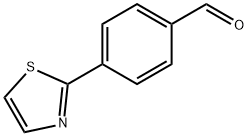4-(1,3-THIAZOL-2-YL)BENZALDEHYDE
- CAS NO.:198904-53-9
- Empirical Formula: C10H7NOS
- Molecular Weight: 189.23
- MDL number: MFCD06797780
- SAFETY DATA SHEET (SDS)
- Update Date: 2023-07-14 17:49:10

Properties of 4-(1,3-THIAZOL-2-YL)BENZALDEHYDE
| Boiling point: | 350.3±44.0 °C(Predicted) |
| Density | 1.269±0.06 g/cm3(Predicted) |
| storage temp. | under inert gas (nitrogen or Argon) at 2-8°C |
| pka | 1.69±0.10(Predicted) |
Safety information for 4-(1,3-THIAZOL-2-YL)BENZALDEHYDE
| Signal word | Warning |
| Pictogram(s) |
 Exclamation Mark Irritant GHS07 |
| GHS Hazard Statements |
H302:Acute toxicity,oral H413:Hazardous to the aquatic environment, long-term hazard |
| Precautionary Statement Codes |
P264:Wash hands thoroughly after handling. P264:Wash skin thouroughly after handling. P270:Do not eat, drink or smoke when using this product. P273:Avoid release to the environment. P330:Rinse mouth. P301+P312:IF SWALLOWED: call a POISON CENTER or doctor/physician IF you feel unwell. |
Computed Descriptors for 4-(1,3-THIAZOL-2-YL)BENZALDEHYDE
New Products
Tert-butyl bis(2-chloroethyl)carbamate 4-Methylphenylacetic acid N-Boc-D-alaninol N-BOC-D/L-ALANINOL 3-Morpholino-1-(4-nitrophenyl)-5,6-dihydropyridin- 2(1H)-one Furan-2,5-Dicarboxylic Acid Tropic acid DIETHYL AMINOMALONATE HYDROCHLORIDE 1,1’-CARBONYLDIIMIDAZOLE R-2-BENZYLOXY PROPIONIC ACID 1,1’-CARBONYLDI (1,2-4 TRIAZOLE) N-METHYL INDAZOLE-3-CARBOXYLIC ACID (2-Hydroxyphenyl)acetonitrile 4-Bromopyrazole 5-BROMO-2CYANO PYRIDINE 5,6-Dimethoxyindanone 5-broMo-2-chloro-N-cyclopentylpyriMidin-4-aMine 2-(Cyanocyclohexyl)acetic acid 4-methoxy-3,5-dinitropyridine 2-aminopropyl benzoate hydrochloride 1-(4-(aminomethyl)benzyl)urea hydrochloride diethyl 2-(2-((tertbutoxycarbonyl)amino) ethyl)malonate tert-butyl 4- (ureidomethyl)benzylcarbamate Ethyl-2-chloro((4-methoxyphenyl)hydrazono)acetateRelated products of tetrahydrofuran
![4-[4-(2,4-DICHLOROPHENYL)-1,3-THIAZOL-2-YL]BENZENECARBOXYLIC ACID](https://img.chemicalbook.in/StructureFile/ChemBookStructure2/GIF/CB9493300.gif)


![METHYL 4-[4-(4-FLUOROPHENYL)-1,3-THIAZOL-2-YL]BENZENECARBOXYLATE](https://img.chemicalbook.in/StructureFile/ChemBookStructure2/GIF/CB9491689.gif)
![4-(4-PHENYL-1,3-THIAZOL-2-YL)-N-[3-(TRIFLUOROMETHYL)PHENYL]BENZENECARBOXAMIDE](https://img.chemicalbook.in/StructureFile/ChemBookStructure2/GIF/CB1320398.gif)
![4-[4-(2,4-DICHLOROPHENYL)-1,3-THIAZOL-2-YL]-N,N-DIMETHYLBENZENECARBOXAMIDE](https://img.chemicalbook.in/StructureFile/ChemBookStructure2/GIF/CB1677672.gif)

![4-(4-PHENYL-1,3-THIAZOL-2-YL)-N-[4-(TRIFLUOROMETHOXY)PHENYL]BENZENECARBOXAMIDE](https://img.chemicalbook.in/StructureFile/ChemBookStructure2/GIF/CB5756030.gif)
You may like
-
 2033-24-1 98%View Details
2033-24-1 98%View Details
2033-24-1 -
 1975-50-4 98%View Details
1975-50-4 98%View Details
1975-50-4 -
 2-HYDROXY BENZYL ALCOHOL 98%View Details
2-HYDROXY BENZYL ALCOHOL 98%View Details
90-01-7 -
 2-Chloro-1,3-Bis(Dimethylamino)Trimethinium Hexafluorophosphate 221615-75-4 98%View Details
2-Chloro-1,3-Bis(Dimethylamino)Trimethinium Hexafluorophosphate 221615-75-4 98%View Details
221615-75-4 -
 61397-56-6 CIS BROMO BENZOATE 98%View Details
61397-56-6 CIS BROMO BENZOATE 98%View Details
61397-56-6 -
 14714-50-2 (2-Hydroxyphenyl)acetonitrile 98+View Details
14714-50-2 (2-Hydroxyphenyl)acetonitrile 98+View Details
14714-50-2 -
 118753-70-1 98+View Details
118753-70-1 98+View Details
118753-70-1 -
 733039-20-8 5-broMo-2-chloro-N-cyclopentylpyriMidin-4-aMine 98+View Details
733039-20-8 5-broMo-2-chloro-N-cyclopentylpyriMidin-4-aMine 98+View Details
733039-20-8
Statement: All products displayed on this website are only used for non medical purposes such as industrial applications or scientific research, and cannot be used for clinical diagnosis or treatment of humans or animals. They are not medicinal or edible.